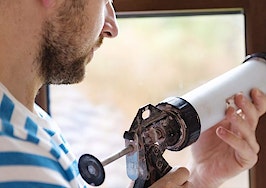We’ve all been there — it’s the morning of an important interview and you go to the dryer to pull out your lucky pair of slacks, and they’re still damp and wrinkled. Boo.
Instead of spending a few hundred dollars on a new dryer, Cord Werner, a certified master inspector for A to Z inspections in Oklahoma City, says homeowners should focus their attention on the dryer vent. A clogged or improperly installed vent will cause your clothes to dry slowly, among other issues, he said.
“A good sign that your dryer vent is clogged and needs to be cleaned is that your clothes will start taking longer to dry,” Werner said. “I actually have a friend where his kids thought their dryer was messed up, so they bought another dryer, and it wasn’t working either. What they found out was that their dryer vent was clogged up.”
Werner and I talked about the most common dryer problems. Here are seven simple facts about dryer vents that can save your buyer time and money:
What’s the purpose of a dryer vent?
The purpose of a dryer vent is that in order to dry your clothes, you need to get rid of the moisture. So, the vent just moves the moisture to the outside of your home.
What’s the proper way to install a dryer vent?
It should be a metal duct, and I say that because in the 80s it was common for builders to use polyvinyl chloride (PVC), and they found out that it’s flammable and can cause house fires. So, it should be a metal duct for safety.

A duct that’s been vented into the attic | Photo credit: Cord Werner
The duct should also vent to the exterior of the home because it’s getting rid of a lot of moisture. Once again, in the 80s and earlier, a lot of builders would vent them into the attic, the crawlspace or even into the garage, which isn’t correct.
What’s the danger of venting into the wrong areas?
There are a couple things that can happen when you vent into the attic, crawlspace or garage. It can create mildew and rot to the surrounding area, and its going to push a lot of lint into that area, and lint is extremely flammable. You could have a spark, and it’s going to start a house fire wherever you have that lint.
How much would it cost a homeowner to fix mildew and rot?
That’s a hard one to say because it varies. It depends on how long it’s been going on and how frequently the dryer is being used. If the attic has good ventilation, [the amount of damage] isn’t horrible. But, especially in the garage, mildew can easily spread across the wall.
So, the repair costs will vary based on how long it has been going on, and if it’s surface mildew or if it’s gotten into the deeper levels of your home. If that’s the case, then you’ll have to think about cutting [parts of the wall out] and replacing it.
How do you fix a dryer that’s located in an area where it’s difficult to vent outside?

An improperly installed rooftop dryer vent vs. a properly installed dryer vent. (Photo credit: Cord Werner)
Well, you can vent out the roof, which is becoming a more common practice. There are length requirements on that, where it’s 35 feet max. But when you start adding elbows, which are turns in the vent, it’s more like 25 feet. Each 90-degree turn in the vent is equivalent to 5 feet, and each 45-degree turn is equivalent to 2.5 feet, so you have to account for those [turns] too.

What a booster fan looks like | Photo credit: Cord Werner
If it’s too long, you’ll have to install a booster fan that has a pressure sensor on it. When you activate the dryer, the fan’s sensor will be activated and will help push the lint and moisture out.
What does it cost a new-home owner to fix an improperly installed dryer vent?
The repair costs will vary. If it’s near an exterior wall, it will be a couple hundred dollars to get the duct replaced and resealed. If the duct goes through the roof and depending on how long the duct is, it can cost $300 to $800.
A professional handyman or tradesman can get it done in a day or two. They’re going to have to go out there and look at [the duct], get their measurements, figure out what material they need and then install it.
What are some dryer vent maintenance tips that all homeowners need to know?
If their dryer vent goes out the roof, then they need to get it cleaned at least once a year and can cost anywhere from $150 to $300. If [the vent] goes out the sidewall, then it’s something they can do themselves. The [sidewall] vent is usually only a foot or two long, and they can disconnect it, wipe it out and reconnect it.

A clogged rooftop dryer vent. (Photo credit: Cord Werner)
But, another thing to keep in mind is that if your vent is out the sidewall, it needs to be a minimum of 6 feet away from the air conditioner. If it’s not, the lint can clog your air conditioner. Also, your air conditioner is trying to get rid of heat, and you’re pushing heat right into it.

If this exhaust vent gets damaged, you’ll need to replace it | Photo credit: Cord Werner
If your duct is metal, it will last for very long time. The exhaust vent is the thing you’ll most likely have to repair. If somebody accidentally hits [the exhaust vent], you’ll have to replace it.







